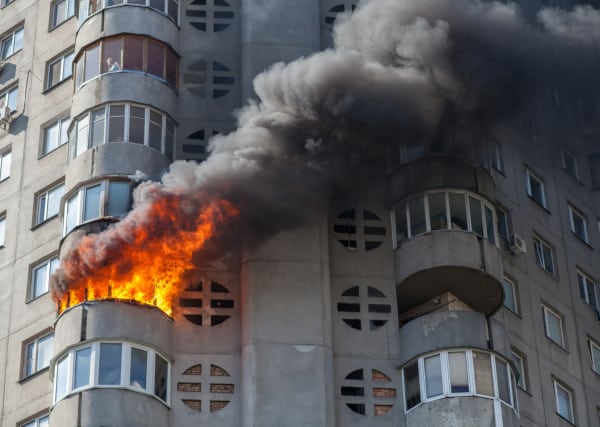Quick response fire sprinklers — and other fast-response models — prioritize escape and survival
Residential buildings, hospitals, offices, and other light-hazard buildings often combine a limited number of escape routes with an abundance of people, which can be a dangerous pairing in a fire emergency. To give people in those structures far better odds of survival, fire sprinkler manufacturers developed the quick response sprinkler. It’s designed, first and foremost, to help people escape burning buildings before it’s too late.
In this article, we explain the mission of quick response sprinkler heads and provide an overview of quick response sprinkler types, characteristics, and identification to help consumers find exactly the head they’re looking for.
If you’d prefer, you can skip straight to our selection of fire sprinklers.
Quick response sprinkler heads delay the most deadly fire scenarios
Fire sprinklers control or suppress fires by soaking ignitable material near the flames. When they control fires, they make it harder for a fire to spread, buying valuable time for the fire department to arrive. The value of this time emphasizes the first benefit and characteristic of quick response sprinklers — as the name illustrates, they go off quickly.
Quick response sprinklers are a type of fast response sprinkler, which is defined by having a response time index (RTI) of 50 (meters-second)1/2 or less. In contrast, standard response heads have an RTI of 80 (meters-second)1/2 or more. The temperature classification of a given QR and SR sprinkler might conceivably be the same — say, 155°F — but the QR sprinkler is more temperature-sensitive and will activate first.
In addition, the spray pattern of quick response fire sprinkler heads—and the design of the systems supplying them with water—emphasize covering nearby walls with lots of water. Soaking the walls serves two purposes. First, fire rises, and most modern buildings feature an abundance of thin walls and flammable materials. Keeping the walls moist slows the fire’s natural upward progression. Second, as fire burns, it emits carbon monoxide (CO) and other gasses that are flammable in the right concentrations. Since CO is slightly lighter than air, it rises with heat currents and accumulates near the ceiling. Keeping the fire contained to the floor keeps the ceiling temperatures (and all the CO it produces) cooler.
Why is that important? Flashover starts when the accumulated carbon monoxide and other gases near the ceiling combust—somewhere around 900 to 1,200 degrees Fahrenheit—setting off a chain reaction that ends with all the oxygen incinerated. Anyone left inside the room dies almost instantly. For a dramatic demonstration of the devastating power of flashover, take a look at the video below:
In short, avoiding flashover is necessary for human survival, and cooler ceiling temperatures help tremendously. Quick response sprinkler system design accomplishes this mission through the proper spacing of heads, early activation, and specialized spray patterns. Tests have shown that quick-response sprinklers can lower temperatures by 400 degrees Fahrenheit over standard-response sprinklers, keeping temperatures well away from flashover.
Sprinkler style or orientation limits appropriate uses and coverage characteristics
Quick response fire sprinkler heads are available in many different styles, temperatures, and colors. But among all that variety, there are four orientations and basic types:
• Pendent: hangs down from piping with the head exposed
• Concealed pendent: installs in ceilings with the head hidden from view behind a cover plate
• Upright: often used with exposed piping, these heads point upward to spray around obstructions
• Horizontal sidewall: mounts to piping behind a wall with the head parallel to the ground.
• Concealed horizontal sidewall: same as above, but hidden behind a cover plate.
Each of these sprinklers is better suited to some applications rather than others. As we’ve covered in our in-depth look at fire sprinkler head types, pendent sprinklers protrude from the ceiling, leaving the frame visible. There are some exceptions: flush or recessed pendent sprinklers keep most of the working parts (like the deflector, frame, and bulb) out of sight. Concealed sprinklers also keep important parts out of sight but do so using decorative cover plates in a variety of finishes.
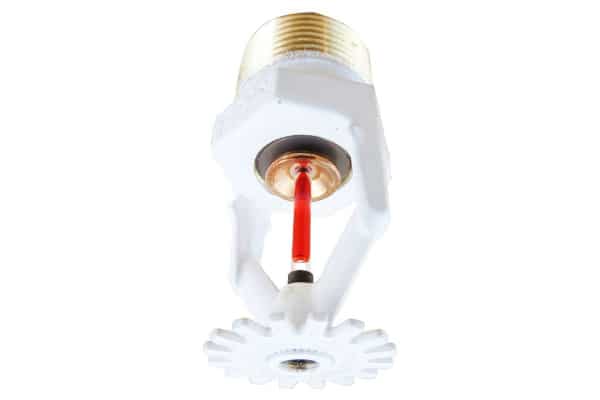
Unlike pendent sprinklers, upright sprinkler heads are used in locations where obstructions interfere with sprinkler coverage or where freezing temperatures threaten to damage sprinkler heads. Similarly, sidewall sprinkler heads are often installed when obstructions, aesthetic concerns, or the configuration of the pipe weigh against the use of other sprinkler types. For example, sidewall sprinklers may be found on the top floors of buildings so overhead horizontal sprinkler pipes aren’t run through an unheated space, like an attic.
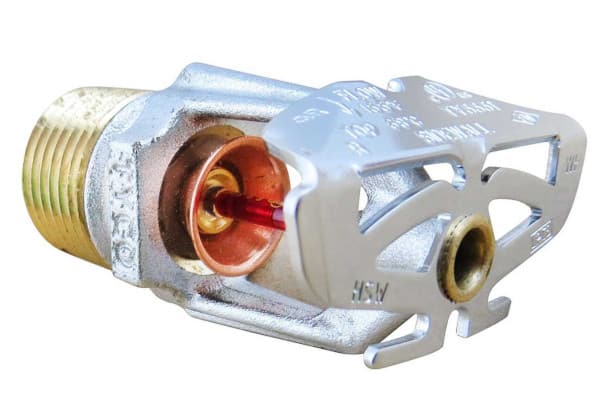
Learn more about fire sprinkler types (orientations) and options by reading our in-depth look here.
Quick response sprinkler heads are available in a variety of temperatures and finishes
In turn, any one of these sprinkler types is available in a variety of temperatures. The temperature at which a quick response fire sprinkler head activates depends on building usage, ambient temperature, the presence of nearby heat sources, and location. The most common temperature is 155 degrees Fahrenheit, but 200 and 286 degrees are also prevalent.
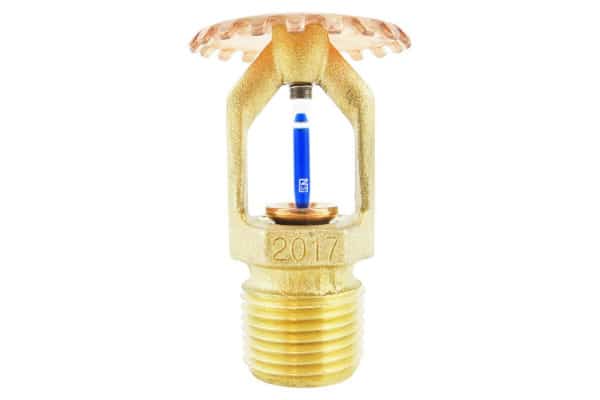
Want to learn more about fire sprinklers’ sensitivity to heat and temperature options? Click here.
Pendent, upright, and horizontal sidewall sprinklers are available in a variety of finishes, with the three most common being brass, chrome, and white. Many manufacturers also offer special corrosion-resistant finishes for humid, outdoor, or coastal environments where ambient moisture quickly degrades metal. Finally, where sprinklers include cover plates, a variety of finishes are available, ranging from the simple colors discussed above to wood-patterned finishes and even custom colors made to match existing ceilings.
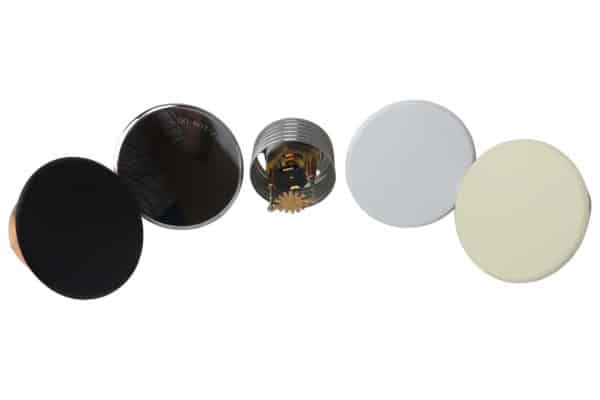
Some basic tips can help consumers identify which quick response fire sprinklers they already have
Many fire sprinklers feature temperature-sensitive bulbs. While the color of that bulb indicates how hot the surrounding air must be for the fire sprinkler to activate, the bulb’s diameter indicates its thermal sensitivity — whether or not it’s a quick response fire sprinkler.
The size of the bulb is usually the easiest way to compare quick response and standard response sprinklers. As pictured below, thicker five-millimeter (5 mm) bulbs are standard response sprinkler heads. Quick response fire sprinklers feature leaner three-millimeter (3 mm) bulbs.
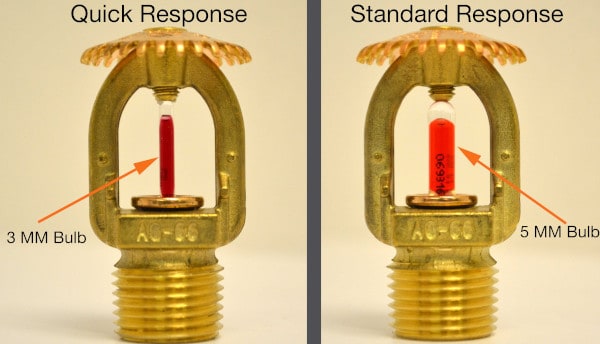
There are some exceptions to this rule, though. Not all quick-response fire sprinkler heads feature bulbs. Some use heat-sensitive metal parts, aka fusible links, that respond to heat by melting instead of breaking like bulbs do.
To find an appropriate match, it’s critical to inspect the sprinkler’s deflector plate. Manufacturers will typically stamp QR (Q.R.) or SR (S.R.) on the deflector’s spindles. It’s also a good idea to find the sprinkler’s model number and enter it into a search engine just to be sure. That model number consists of four to six letters and numbers, beginning with one or two letters to indicate the manufacturer like TY for Tyco, V for Victaulic, and so on.
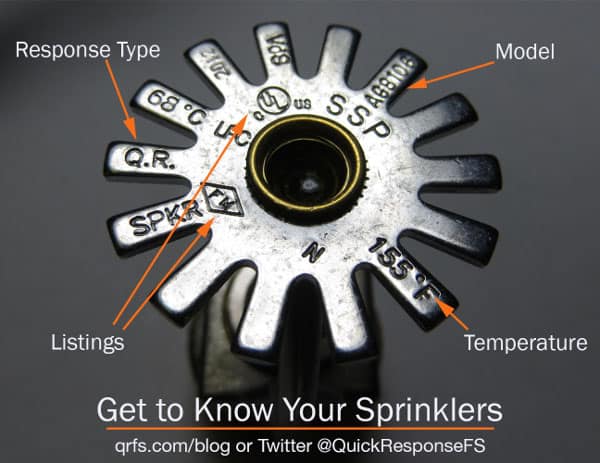
For an in-depth look at identifying and replacing an existing fire sprinkler head, click here.
QRFS makes it easy to find the quick response sprinkler you need
Now that you’ve got a handle on the basics of quick response fire sprinklers. check out QRFS’s selection of residential, standard response, quick response pendents, concealed pendents, uprights, and sidewalls from Victaulic, Tyco, Senju, Viking, and more in a variety of temperatures and finishes.
These UL-listed and FM-approved fire sprinklers comply with standards for NFPA fire sprinkler systems, including commercial (NFPA 13), residential (NFPA 13R), and home fire sprinkler systems (NFPA 13D).
Click here to browse our selection of fire sprinklers.
Questions? Need some help identifying or replacing your quick response sprinkler? Call us at (888) 361-6662 or email support@qrfs.com.
This blog was originally posted by Jason Hugo at blog.qrfs.com on March 6, 2016, and updated on August 19, 2022. If this article helped you find the sprinkler you needed, check us out at Facebook.com/QuickResponseFireSupply or on Twitter @QuickResponseFS.


